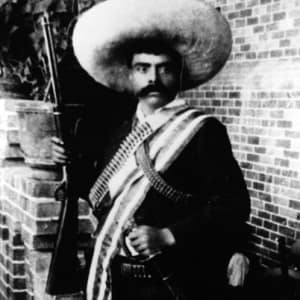
Emiliano Zapata
Emiliano Zapata was a leading figure in the Mexican Revolution (1910–1920), during which he formed and commanded the Liberation Army of the South, an important revolutionary brigade. Followers of Zapata were known as Zapatistas.
Synopsis
Born on August 8, 1879, Anenecuilco, Mexico, Emiliano Zapata was a Mexican revolutionary and advocate of agrarianism who fought in guerrilla actions during the Mexican Revolution. He formed and commanded the Liberation Army of the South, an important revolutionary brigade, and his followers were known as Zapatistas. Zapata died on April 10, 1919.
Early Years
Born on August 8, 1879, Emiliano Zapata was orphaned at the age of 17. A revolutionary from an early age, in 1897 he was arrested because he took part in a protest by the peasants of his village against the hacienda (plantation) that had appropriated their lands. After he was pardoned, he continued to agitate among the peasants, and because of his rabble-rousing, he was subsequently drafted into the Mexican army. After serving for only six months, Zapata was discharged to a landowner to train his horses in Mexico City. In 1909 his leadership skills were already well known, and he was summoned to his village of birth, Anenecuilco, where he was elected as the village’s council board president.
Early Agrarian Battles
A man of the people, Emiliano Zapata became a leading figure in Anenecuilco, where his family had lived for many generations, and he became involved in the struggles of the local peasant farmers. There were many conflicts between villagers and landowners over the continual theft of village land, and in one instance, the landowners set an entire village on fire in response to peasant protests. Zapata managed to oversee the return of the land from some haciendas peacefully, but it was an ongoing struggle. At one point, after failed negotiations, Zapata and a group of peasants occupied by force the land that had been appropriated by the haciendas and distributed it among themselves.
During this time, and for many years to follow, Zapata continued to faithfully campaign for the rights of the villagers, using ancient title deeds to establish their claims to disputed land, and then pressuring the governor of the region to act. Finally, in the face of the glacial pace of governmental response and the clear favoritism toward the wealthy plantation owners, Zapata started to use force, simply taking over the disputed land and distributing it as he saw fit.
The Revolution Begins
Around this time, Mexican president Porfirio Díaz was being threatened by the candidacy of Francisco Madero, who had lost the 1910 election to Díaz but had subsequently fled the country, declared himself president and then returned to confront Díaz.
In Madero, Zapata saw an opportunity to promote land reform in Mexico, and he made a quiet alliance with Madero. Zapata was wary about Madero, but he cooperated once Madero made promises about land reform, the only issue Zapata truly cared about.
In 1910, Zapata joined Madero’s campaign against President Díaz, taking on an important role as the general of the Ejército Libertador del Sur (Liberation Army of the South). Zapata’s army captured Cuautla after a six-day battle in May 1911, a clear indication that Díaz’s grasp on power was tenuous at best. The battle was described as "six of the most terrible days of battle in the whole Revolution,” and it was clearly a clarion call to the Zapatistas. When Díaz’s men withdrew, Zapata’s forces took control of the town. This defeat, paired with defeat at the First Battle of Ciudad Juárez at the hands of Pancho Villa and Pascual Orozco, led Díaz to determine that his time was up. A week later, he resigned and headed to Europe, leaving behind a provisional president.
Francisco Madero entered Mexico City in victory, and Zapata met him there to ask him to exert pressure on the provisional president to return misappropriated land to its original landowners, again returning to the cause most deeply embedded in his heart.
Madero insisted on the disarmament of Zapata’s guerrillas and offered Zapata money to buy land if he could ensure the disarmament. Zapata rejected the offer but began to disarm his forces regardless. He soon stopped the process, however, when the provisional government sent the military to confront the guerrillas.
The Revolution Deepens: The Plan of Ayala
Following Zapata’s rebuff of Madero’s offer, relations between the two soured, and in the summer of 1911, Madero appointed a governor who supported plantation owners’ rights over those of the peasant farmers, angering Zapata. Attempts at compromise between the two fell flat in November 1911, days after Madero became president of Mexico, and Zapata fled to the mountains.
Disillusioned with Madero’s stances on land ownership and his post-revolutionary stances generally, Zapata prepared the Plan of Ayala, which declared Madero incapable of fulfilling the initial and ongoing goals of the revolution.
With the Plan of Ayala, the Revolution was renewed, this time with Madero in its sights instead of Díaz. The Plan promised to appoint a provisional president until there could be legitimate elections and pledged to buy back a third of the (stolen) land area held by the haciendas and return it to the farmers. Any hacienda that refused to accept this plan would have their lands taken, without recompense. Zapata also adopted the slogan "Tierra y Libertad" ("Land and Liberty").
With Zapata’s Revolution an ongoing event, in 1913 General Victoriano Huerta assassinated Francisco Madero and took control of the country. Huerta soon approached Zapata, offering to unite their troops, but Zapata rejected Huerta's offer.
This prevented Huerta from sending his troops to confront the guerrillas of the north, who, under the direction of Venustiano Carranza, had organized a new army, led by Pancho Villa, to defeat him. Huerta was then forced to leave the country in July 1914.



